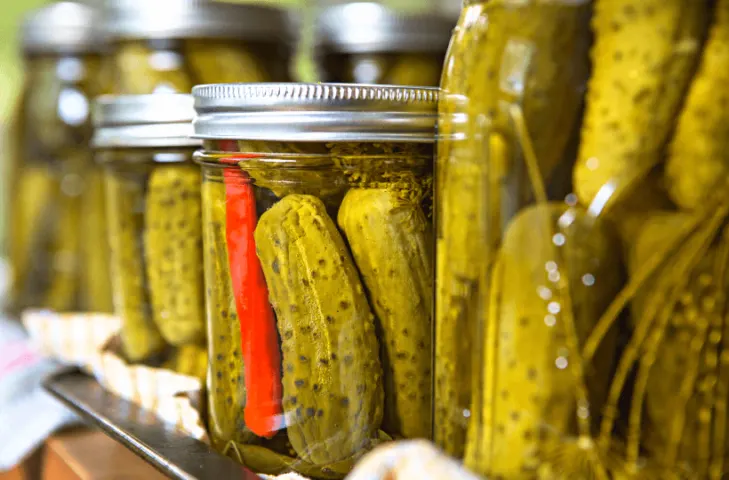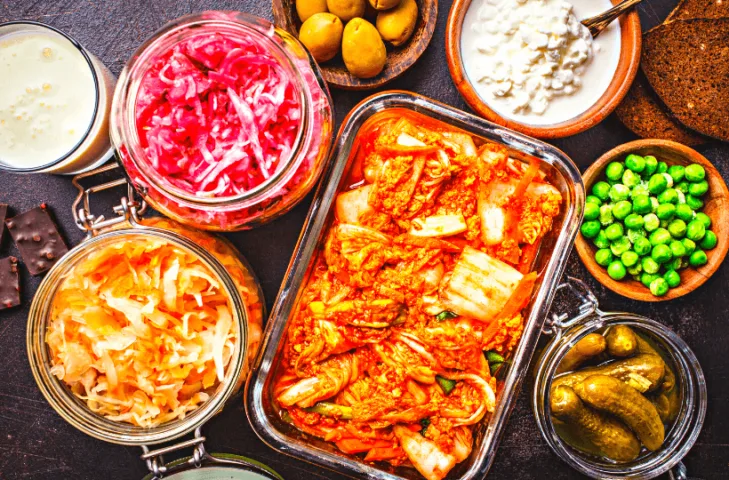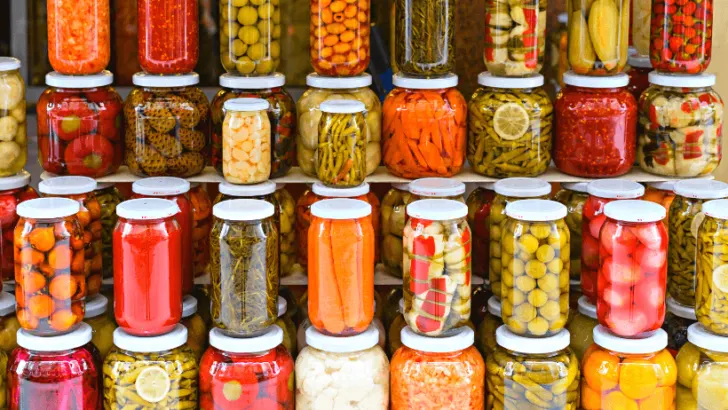Pickling and fermenting are both natural methods of preserving food that often get confused with each other. Although they are very similar in look and produce a tangy, sour taste, they work in separate ways to preserve food.
In short, pickling requires added acid to preserve food and fermentation activates the natural production of lactic acid without any added acidic ingredients.
When evaluating the final products, fermented foods have beneficial bacteria created through the fermentation process that add a fizzy, funky quality to the food. Pickled foods are tangy and acidic, but do not have additional bacteria or carbonation.
These are the basic differences between pickling and fermentation. We’ll dive into the specifics of each later on.
If you have a vegetable garden, fruit plants, or a homestead where you grow your own food, it behooves you to learn about as many food preservation methods as possible. Both pickling and fermenting are effective, healthy, and delicious ways to make your harvest last longer!
What is Pickling?
Pickling is preserving food by soaking it in an acidic solution and applying heat to it to kill and inhibit the growth of microorganisms. The acidic solution is usually comprised of vinegar, water, and salt. Other ingredients, such as sugar, spices, or herbs can be added to change the taste of the pickle.
There are 3 variations of pickling – refrigerator pickles (also known as quick-pickles), canned vinegar pickles, and chutney/relishes. They each have varying shelf lives, percentages of acid in the solution, and storage requirements.
Refrigerator Pickles (Quick Pickles)
Quick pickles typically use less vinegar than traditional pickles and will also go bad faster. Refrigerator pickles are so named because the best way to keep them fresh and crunchy is by storing them in the (you guessed it) refrigerator.
They are made by boiling a mixture of vinegar, salt, water, sugar (optional), and spices and then pouring the hot mixture over the food you are pickling. Using this method, pickled food can be eaten within 1 hour (although it’s often suggested to wait at least 24 hours to obtain maximum flavor infusion).
Quick pickles typically have a shelf life of around 2 – 3 weeks in the refrigerator. However, I’ve had quick-pickled red onions last in the fridge for two months and still be edible.
Canned Vinegar (Regular) Pickles
Regular canned pickles require more planning and effort than quick pickles. Canned pickles are also made with higher proportions of vinegar, salt, and sugar than quick pickles. The jars are then processed in a hot water bath to both inhibit the growth of microorganisms and seal the jar to prevent exposure to oxygen.
These types of pickles are shelf-stable and are often stored in a cupboard, basement, or root cellar. They can last anywhere from 6 months to 2 years on the shelf, although it is often recommended to open them within a year. After being opened and stored in the refrigerator, these pickles may last another year or longer.
Chutney/Relishes
Chutneys and relishes are different in the fact that they are multiple ingredients chopped up or mixed together into a sauce. The pickling method is most similar to the vinegar canned pickles.
They are often, but not always processed in a boiling water bath. These kinds of pickles have a shelf or fridge life from a couple of months up to a year or more.

Common Pickled Foods
We are all familiar with the common sweet and dill pickles (pickled cucumbers). But there are many other foods that can be pickled that you may not be aware of.
Vegetables: Many vegetables are suitable for pickling, including cucumbers, onions, peppers, carrots, and beets. Pickled vegetables are crisp and tangy, and can be used as a condiment or snack.
Fruits: Fruits can also be pickled, although it is less common. Some examples of pickled fruits include watermelon rind, apples, and peaches. Pickled fruits are sweet and tangy, and can be used in savory dishes or as a topping for desserts.
Eggs: Pickled eggs are a popular snack in some parts of the world. They are made by hard-boiling eggs and then pickling them in vinegar or brine. Pickled eggs have a firm, creamy texture and a tangy flavor.
Meat: Pickled meats, such as corned beef and pastrami, are made by curing the meat in brine and then cooking it. Pickled meats have a salty, savory flavor and are often served as sandwiches or as part of a charcuterie board.
Fish: Fish is also commonly pickled, particularly in Scandinavian and Eastern European cuisines. Pickled fish is made by curing the fish in brine or vinegar, and it has a distinctive sour and salty flavor. Some common types of pickled fish include herring, salmon, and mackerel.
There are some foods that are not well-suited for pickling, such as lettuce, tomatoes, and most other types of fresh greens. These foods do not hold up well to the pickling process and can become mushy or spoil quickly. It is generally best to stick to firmer, more acidic foods when pickling.
What is Fermenting?
Fermenting is a preservation method in which microorganisms such as bacteria or yeast are used to convert sugars and other carbohydrates in food into alcohol or acids.
Like pickling, there are also 3 types of fermentation – lactic acid fermentation, alcoholic fermentation, and acetic acid fermentation. To learn more about fermentation, check out our in-depth guide here: Intro To At-Home Fermentation.
Lacto-Fermentation
Lactic acid fermentation is a process in which bacteria known as lactobacilli convert sugars into lactic acid. It only requires water, salt, and the naturally occurring sugars found in the food to change the starches and sugars into acid.
This type of fermentation is commonly used to preserve and flavor a variety of foods, including pickles, sauerkraut, kimchi, and yogurt. Lacto-fermentation is commonly confused with pickling, but they are in fact different.
If you’re interested in trying Lacto-fermentation at home, try one of these 28 Easy Fermentation Recipes.
Alcoholic Fermentation
Alcoholic fermentation is a process in which yeast converts sugars into alcohol and carbon dioxide. The yeast can either be the naturally occurring yeast that’s found on fruit’s skin or in cellars, or a cultivated yeast can be used to get the fermentation process going immediately.
This type of fermentation is used in the production of alcoholic beverages, such as beer, wine, and cider. It is also used in the production of some bread, such as sourdough.
Acetic Acid Fermentation
This type of fermentation is also known as natural fermentation and usually requires a SCOBY (symbiotic combination of bacteria and yeast) or other starter culture made up of living organisms.
The acetic acid fermentation method is used to create kombucha, sourdough, kefir, ginger beer, apple cider vinegar, and red or white wine vinegar.

Health Benefits of Fermented Foods
Fermented foods have a long history of being a part of the human diet, and they are thought to have a number of potential health benefits. Some of the potential benefits of eating fermented foods include:
Improved digestion: Fermented foods contain high levels of beneficial bacteria, known as probiotics, which can help to improve digestion and boost the immune system. Probiotics are thought to help balance the bacteria in the gut, which can help to improve digestion and prevent digestive disorders such as constipation and diarrhea.
Enhanced nutrient absorption: Fermentation can help to break down the nutrients in foods, making them more easily absorbed by the body. This can help to improve the overall nutritional value of fermented foods.
Boosted immunity: The beneficial bacteria found in fermented foods can help to boost the immune system and protect against illness. Some research suggests that consuming fermented foods may help to reduce the risk of certain infections and allergies.
Reduced risk of chronic diseases: Some studies have suggested that consuming fermented foods may help to reduce the risk of certain chronic diseases, such as heart disease and certain types of cancer.
It’s worth noting that not all fermented foods are created equal, and some may have a higher concentration of probiotics and other beneficial compounds than others.
It’s also important to be aware that fermented foods can sometimes contain high levels of salt, so it’s important to pay attention to serving sizes and choose fermented foods that are lower in salt when possible.
As always, consult your doctor before making significant changes to your diet. There can also be negative side effects from eating too much fermented food.

Pickling vs Fermenting FAQs
Are pickles fermented?
They can be fermented. Most pickles you find at the grocery store or get served at a restaurant are not fermented. Fermented pickles are a probiotic food (if they are not pasteurized), while vinegar pickles are not.
If the pickles are pasteurized, the heat will kill the probiotics. Therefore, fermented pickles with probiotics must be refrigerated. Shelf-stable pickles sold in the canned vegetable or condiment aisle do not have probiotics.
One of the best ways to know if pickles have probiotics is to check the label. If vinegar is listed as an ingredient, then they will not have the probiotics. Also, the label should have the words “fermented,” “unpasteurized,” and/or “probiotic.”
Is pickling a form of fermentation?
No. Regular pickling requires vinegar and the application of heat, which devoids the food of all microorganisms.
Can you get botulism from fermented vegetables?
It is possible but extremely rare to contract botulism from fermented foods. C. botulinum is averse to high-acid environments, such as a heavily salted ferment or vinegar pickle. For more information on botulism, refer to this webpage from the CDC.
Does pickling cause loss of nutrients?
Some water-soluble vitamins, such as vitamins B and C, are destroyed during the pickling process. But, for the most part, pickled foods retain most of their nutrition.
Does pickling get rid of bacteria?
Yes, the pickling process kills all bacteria, both good and bad. However, if the pickles are not stored completely submerged in their brine, they can grow mold.
Can you use regular mason jars for fermenting and pickling?
Yes! This is the easiest and most common vessel to both ferment and pickle food in.

